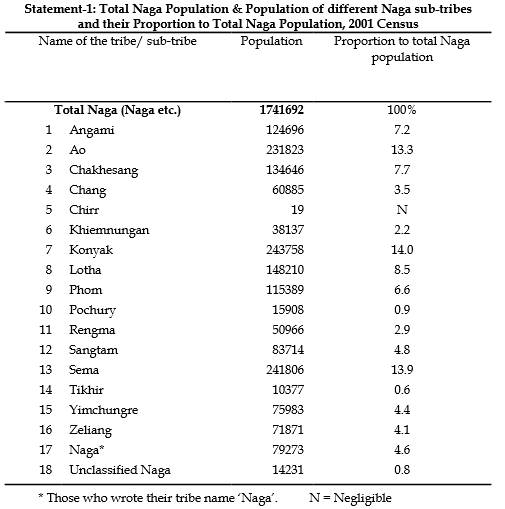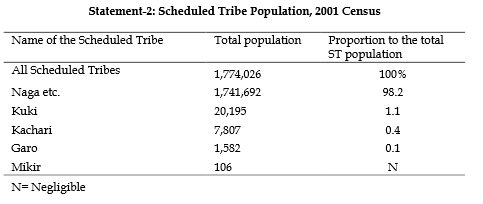Nagaland
This article has been sourced from an authoritative, official readers who wish to update or add further details can do so on a ‘Part II’ of this article. |
Contents |
The source of this section
INDIA 2012
A REFERENCE ANNUAL
Compiled by
RESEARCH, REFERENCE AND TRAINING DIVISION
PUBLICATIONS DIVISION
MINISTRY OF INFORMATION AND BROADCASTING
GOVERNMENT OF INDIA
Nagaland
Area : 16,579 sq km
Population : 19,80,602 (Prov. Census 2011)
Capital : Kohima
Principal Languages : English, Hindi and 16 tribal Dialects
History And Geography
Nagaland, the 16th State of the Indian Union, was established on 1 December 1963. It is bound by Myanmar on the east, Arunachal on the north, Assam on the west and Manipur on the South. It lies between the parallels of 98 degree and 96 degree East Longitude and 26.6 degree and 27.4 degree latitude North of the Equator.
The State of Nagaland has an area of 16,579 sq km with a population of 19,88,636 as per the 2001 census. The State is mostly mountainous except those areas bordering Assam valley. Mount Saramati is the highest peak in Nagaland with a height of 3,840 meters and its range forms a natural barrier between Nagaland and Myanmar.
The Nagas belong to the Indo-Mongoloid group of people living in the contiguous areas of the North Eastern hills of India and the upper portion of Western Myanmar. The major-recognised tribes of Nagaland are Angami, Ao, Chakhesang, Chang, Khiamniungan, Kuki, Konyak, Lotha, Phom, Pochury, Rengma, Sangtam, Sumi, Yimchungru and Zeliang. The Naga languages differ from tribe to tribe and sometimes even from one village to another. They are, however, under the Tibeto- Burma family.
In the 12th and 13th centuries, gradual contacts with the Ahoms of present -day Assam was established but this did not have any significant impact on the traditional Naga way of life. However, in the 19th Century the British appeared on the scene and ultimately the area was brought under British Administration. After Independence this territory was made a centrally administered area in 1957 administered.
Nagaland: The Scheduled Tribes Census Of India 2001
The population of Nagaland in 2001 Census has been 1,99 0,036. Of these, 1,774,026 are Scheduled Tribes (STs) constituting 89. 1 per cent of the total population of the state. The State has registered dec adal growth of 67.2 per cent in ST population in 1991-2001. Nagaland has five communit ies notified as STs. These are Garo, Kachari, Kuki, Mikir, and Naga.
2. Naga is a generic name for several groups, each ha ving distinct identity. In 1971 Census, figures of sixteen Naga sub-tribes were given separately for the first time. They were: (i) Angami, (ii) Ao, (iii) Chakhesa ng, (iv) Chang, (v) Chirr, (vi) Khiemnungan, (vii) Konyak, (viii) Lotha, (ix) Makware, (x) Phom, (xi) Rengma, (xii) Sangtam, (xiii) Sema, (xiv) Tikhir, (xv) Yimc hungre, and (xvi) Zeliang.
Subsequently, in 1991 Census, Pochury Naga was added and their number shown separately. In 2001 Census, no population of Makware has been returned. Instead, sizeable population has returned either as ‘Naga’ or as sub-tribes other than the seventeen Naga sub-tribes hitherto published in Census. These have been thus separately grouped under ‘Naga’ and ‘Unclassified Nag as’ respectively. Total Naga population in the state thus includes population of all Naga sub-tribes as well as ‘Naga’ and ‘Unclassified Nagas’ (Statement-1)
Population: Size and Distribution
3. Of the five communities notified as STs in Nagala nd, the Naga constitutes 98.2 per cent. Sema, Konyak, Ao, Lotha, Chakhesang, Angam i, Phom, etc. are major Naga sub-tribes, each having more than one lakh population as per 2001 Census. Kuki is the second largest ST having only 1.1 per cent of the state’s total ST population. Kachari and Garo account for less than one per cent. Mikir is the smallest among STs in the state; only 106 persons of Mikir have been returned at 2001 Census.
4. Majority of the ST population (87%) lives in rura l areas. Of the seventeen Naga sub-tribes, Lotha, Ao, Angami, and Chang, each h ave more than 16 per cent urban residents. On the other hand, Tikhir, Phom, Pochury , and Zeliang are having less than 5 per cent urban population. Lotha is the most urbanized tribe with 28.8 per cent urban population, while Tikhir is the least urbanized (0.6%).
Sex Ratio
5. As per 2001 Census, sex ratio of total ST popula tion is 943. Among the Naga sub-tribes, females outnumbered males in Angami (1004). Besides, nine (9) other tribes have sex ratio above 950. Among the sub- groups of Naga having more than one lakh population in 2001, Phom has recorded low sex ratio of 891.
6. Child sex ratio (0-6 age group) of tribal popul ation of the state is 969 and 18 tribes including Naga sub-tribes have recorded 950 or above child sex ratio. Tikhir has recorded very low child sex ratio of 831.
Literacy and Educational level
7. As per 2001 Census, 66 per cent of the total ST p opulation is literate, with male and female literacy at 70.3 and 61.3 per cent re spectively. The percentage of literates among Naga is 65.8 per cent. Wide dispari ty is discerned among the seventeen Naga sub-tribes. For example, Ao is at the top with literacy rate of 85.9 per cent, while Konyak is at the bottom with literacy rate of 40.2 per cent.
8. Among the ST literates, 23.5 per cent are either w ithout educational level or have below primary level education. Primary level of literates account for 28 per cent while 15 per cent have attained Matric/ Seconda ry level education. 9. 68.3 per cent of the ST population in the age group 5-14 has been attending educational institutes in 2001 Census. Four tribes namel y Kachari, Naga etc., Angami, and Lotha have recorded more than 80 per cent c hildren (5-14) attending school/ educational institutions in 2001.
Work Participation Rate (WPR)
10. Among the STs, 42.3 per cent of the population ha s been recorded as workers. Gender-wise, the female WPR at 40.1 per cen t is a little lower than male (44.5%). There is no noticeable disparity among the d ifferent STs with regard to WPR.
11. Of the total workers among the STs, 82.2 per cent have been reported as main workers and 17.8 per cent as marginal workers. T he percentage of female main workers at 78.1 per cent is slightly lower than mal e (85.8%). This speaks for almost equitable male-female participation in economi c pursuits.
Category of Workers
12. Among main workers, an overwhelming 72.7 per cent of the ST population has been recorded as cultivator. A significant perce ntage of main workers (15.5%) are engaged in ‘manufacturing and repairs’ work.
Marital Status and Fertility
13.The distribution of ST population by marital sta tus shows that 65.3 per cent is never married, 32.4 per cent currently married, 1.8 per cent widowed, and 0.5 per cent divorced & separated.
14. Merely 1.5 per cent of the ST female population below 18 years – the legal age for marriage – has been recorded as ever marrie d. The percentage of ever married ST male below 21 years at 1.2 per cent is al so low.
15. Among STs, the average number of children ever born per ever married woman in the age group 45-49 years is just over five.There are skewed variations among the seventeen Naga sub-tribes. Among Angami, Ao, and Khiemnungan it less than five, while among the Rengma and Chang it is e xceeding six.
Religion
16. The majority of the ST population of Nagaland is Christians. In 2001 Census, 98.5 per cent of the ST population has returned as Christians.
See also
Indpaedia’s several pages about Nagaland include:
Nagaland


